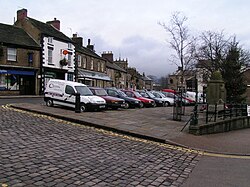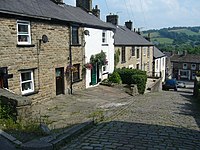Chapel-en-le-Frith: Difference between revisions
Created page with '{{Infobox town |name=Chapel-en-le-Frith |county=Derbyshire |picture=Chapel-en-le-Frith.JPG |picture caption=Market Square, Chapel-en-le-Frith |population=8,821 |census year=200…' |
No edit summary |
||
| (One intermediate revision by one other user not shown) | |||
| Line 15: | Line 15: | ||
|constituency=High Peak | |constituency=High Peak | ||
}} | }} | ||
'''Chapel-en-le-Frith''' is a small town in [[Derbyshire]], | '''Chapel-en-le-Frith''' is a small town in [[Derbyshire]], found on the edge of the [[Peak District]] near the border with [[Cheshire]] and 21 miles from [[Manchester]]. It is dubbed "The Capital of the Peak District" at least locally, a claim that would be disputed, politely, by [[Buxton]] | ||
Chapel-en-le-Frith was established by the Normans in the 12th century, originally as a hunting lodge within the Forest of High Peak. This led to the French-derived name of ''Chapel-en-le-Frith'' ("Chapel in the forest").<ref>[http://www.chapel-en-le-frithparishcouncil.gov.uk/parishhistory.htm Parish Council history page]</ref> The population of 'Chapel', as the locals commonly refer to it, is approximately 10,000. | Chapel-en-le-Frith was established by the Normans in the 12th century, originally as a hunting lodge within the Forest of High Peak. This led to the French-derived name of ''Chapel-en-le-Frith'' ("Chapel in the forest").<ref>[http://www.chapel-en-le-frithparishcouncil.gov.uk/parishhistory.htm Parish Council history page]</ref> The population of 'Chapel', as the locals commonly refer to it, is approximately 10,000. | ||
| Line 45: | Line 45: | ||
==Outside links== | ==Outside links== | ||
[[File:Church Brow - geograph.org.uk - 901985.jpg|right|thumb|200px|Church Brow]] | |||
*[http://www.chapel-en-le-frithparishcouncil.gov.uk/ Chapel-en-le-Frith Parish Council] | *[http://www.chapel-en-le-frithparishcouncil.gov.uk/ Chapel-en-le-Frith Parish Council] | ||
*[http://www.chapel-en-le-frith.com/ Chapel-en-le-Frith.com website] | *[http://www.chapel-en-le-frith.com/ Chapel-en-le-Frith.com website] | ||
Latest revision as of 19:41, 15 August 2014
| Chapel-en-le-Frith | |
| Derbyshire | |
|---|---|
 Market Square, Chapel-en-le-Frith | |
| Location | |
| Grid reference: | SK055806 |
| Location: | 53°19’19"N, 1°55’1"W |
| Data | |
| Population: | 8,821 (2001) |
| Post town: | High Peak |
| Postcode: | SK23 |
| Dialling code: | 01298 |
| Local Government | |
| Council: | High Peak |
| Parliamentary constituency: |
High Peak |
Chapel-en-le-Frith is a small town in Derbyshire, found on the edge of the Peak District near the border with Cheshire and 21 miles from Manchester. It is dubbed "The Capital of the Peak District" at least locally, a claim that would be disputed, politely, by Buxton
Chapel-en-le-Frith was established by the Normans in the 12th century, originally as a hunting lodge within the Forest of High Peak. This led to the French-derived name of Chapel-en-le-Frith ("Chapel in the forest").[1] The population of 'Chapel', as the locals commonly refer to it, is approximately 10,000. Despite the lack of flat ground, the town has a golf club, a cricket club and a football club. It has two schools too.
Church of St Thomas Becket
The first chapel in the town gave it a name, though that chapel was demolished during the Middle Ages and replaced by the current parish church, St Thomas Becket. The church stands at the highest point in the town.
The current church is now almost entirely of 18th-century construction. Buried in the churchyard are soldiers of the Scottish army of the Duke of Hamilton who marched south in support of King Charles I in 1648. After their defeat at Preston, they were marched to Chapel and imprisoned in the church for sixteen days in such squalid conditions that forty died; a further ten died when they were marched towards Cheshire. The Eccles Pike Cross lies in the churchyard. It was moved here from Ollerenshaw Farm in 1925. It is believed to be Anglo-Saxon and is covered in very worn carvings.[2]
Customs
A curfew bell has been rung in the town since 1070, and on Shrove Tuesday a Pudding Bell is rung at eleven in the morning to remind housewives to prepare their batter.
There is a regular market place, cobbled and raised above the High Street, which is still used every Thursday to host the local market (though due to the current economic climate the number of stalls present has declined considerably). A market cross has a faint date which may read 1636, but the cross itself is considerably older.[2]
Industry
There is a certain amount of industry — especially behind the church in the lowest part of the town, where the brake-lining manufacturer Ferodo (an anagram of Frood, the 19th-century founder's name, with the addition of a letter "e") was a family concern for over a hundred years; it is now part of the international conglomerate Federal-Mogul.
Institutions
Chapel Poor Law Union was established in December 1837. The union workhouse was built c.1840 on the Whaley Bridge road (SK051805). It consisted of an entrance range and an accommodation block of three wings centred on an octagonal hub, an infirmary and an isolation hospital. The workhouse was later converted to an old people's home, and was demolished in the early 1980s.[3]
Media
High Peak Radio, Independent Local Radio for High Peak and the Hope Valley, broadcasts from studios just off the High Street.
Moorlands
To the north lie the Dark Peak highlands, which are made up of millstone grit and are heather-covered, rugged and bleak. Here are Chinley Churn and South Head with, a little further off, Kinder Scout, which looms above the whole area.
To the south is the gentler and more pastoral White Peak, consisting largely of limestone grasslands, nevertheless with spectacular bluffs and the occasional gorge. Combs Moss, a gritstone 'edge', dominates the valley in which Chapel lies from the south and Eccles Pike rises sharply above the town to its west.
Outside links

- Chapel-en-le-Frith Parish Council
- Chapel-en-le-Frith.com website
- Chapel-en-le-Frith Primary School
- Chapel-en-le-Frith High School
- The Church of St Thomas Becket
- Chapel Golf Club
- Chapel-en-le-Frith Cricket Club
References
- ↑ Parish Council history page
- ↑ 2.0 2.1 Neville T. Sharpe, Crosses of the Peak District (Landmark Collectors Library, 2002)
- ↑ Higginbotham, P. (2007), Workhouses of the Midlands, Tempus, Stroud. Page 27. ISBN 978-0-7524-4488-8